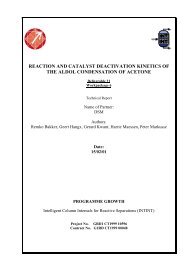MANUFACTURING OF COLUMN INTERNALS NO. 3 (INT 3) AND ...
MANUFACTURING OF COLUMN INTERNALS NO. 3 (INT 3) AND ...
MANUFACTURING OF COLUMN INTERNALS NO. 3 (INT 3) AND ...
You also want an ePaper? Increase the reach of your titles
YUMPU automatically turns print PDFs into web optimized ePapers that Google loves.
<strong>MANUFACTURING</strong> <strong>OF</strong> <strong>COLUMN</strong> <strong><strong>INT</strong>ERNALS</strong> <strong>NO</strong>. 3 (<strong>INT</strong> 3)<br />
<strong>AND</strong> THEIR MODIFICATION (MATERIALS)<br />
Deliverable 54<br />
Workpackage 9<br />
Technical Report<br />
Authors:<br />
T.A. Nijhuis, F. Kapteijn, J.A. Moulijn<br />
Date:<br />
19/05/00<br />
Distribution:<br />
Frédéric Gouardères, European Commission,<br />
Andrzej Górak, University of Dortmund<br />
Eugeny Kenig, University of Dortmund<br />
Oliver Bailer, SULZER<br />
Harald Baeder, BASF<br />
Remko Bakker, DSM<br />
Willem Levering, SULZER<br />
Jacob Moulijn, University of Delft<br />
Hans Hasse, University of Stuttgart<br />
Wieslaw Salacki, PLOCK<br />
Jiri Klemes, UMIST<br />
Andrzej Kraslawski, Lappeenranta University of Technology<br />
Joerg Zellmer, MONTZ<br />
Florian Menter, AEA<br />
Maria Majchrzak, ICSO<br />
Andrzej Kolodziej, IIC<br />
Ion Ivanescu, PETROM<br />
Valentin Plesu, University „Politehnica” of Bucharest<br />
PROGRAMME GROWTH<br />
Intelligent Column Internals for Reactive Separations (<strong>INT</strong><strong>INT</strong>)<br />
Project No. GRD1 CT1999 10596<br />
Contract No. G1RD CT1999 00048
Intelligent Column Internals for Reactive Separations Page 2 of 3<br />
Deliverable No. 54 Issued: 19.05.00<br />
<strong>INT</strong> 3 will be Sulzer KATAPAK-S Laboratory packing.<br />
Technical data:<br />
Gauze:<br />
Material: SS 1.4401<br />
Mesh size: 0.25 mm<br />
Wire thickness: 0.5 mm<br />
Catalyst:<br />
Particle diameter between 0.63 – 1.5 mm,<br />
optimal 80% between 0.8 – 1.0 mm<br />
Element height:<br />
Labor: 100 mm and 200 mm<br />
Unit Laboratory<br />
Specific surface area m²/m³ 270<br />
Catalyst fraction Vol.% 21<br />
Layer height mm 4<br />
"Sandwich thickness" mm 8<br />
Corrugation angle ° 45<br />
Corrugation stepsize mm 12<br />
NTSM 1/m 3<br />
Pictures:<br />
KATAPAK-S packing in a 1.2 m reactor KATAPAK-S<br />
Delivery time for packing: 1 month.
Separation efficieny [NTSM]<br />
Pressure drop [mbar/m]<br />
REACTIVE DISTILLATION USING<br />
KATAPAK-S – Technical Data<br />
Intelligent Column Internals for Reactive Separations Page 3 of 3<br />
Deliverable No. 54 Issued: 19.05.00<br />
Measurements of the separation efficiency<br />
and pressure drop of KATAPAK-S laboratory<br />
packing were carried out in a 70 mm diameter<br />
distillation column for the test system chlorobenzene<br />
/ ethylbenzene at total reflux. The<br />
separation efficiency is almost constant<br />
(NTSM = 3) up to F-factors of about 1.5 Pa 0.5 .<br />
At F-factors above 1.5 Pa 0.5 , NTSM rapidly<br />
increases due to better gas/liquid mass<br />
transfer as more liquid runs on the outside of<br />
the sandwiches. Flooding of the packing occurred<br />
at F-factors around 1.9 Pa 0.5 .<br />
6<br />
5<br />
4<br />
3<br />
2<br />
1<br />
0<br />
100<br />
10<br />
1<br />
0.1<br />
0.1 1 10<br />
F-factor [Pa0.5 ]<br />
Separation efficiency and pressure drop<br />
KATAPAK-S laboratory (70 mm)<br />
Test system: CB/EB<br />
The dynamic hold-up is shown in the next<br />
diagram. Water was used as test system.<br />
Dynamic hold-up [m 3 /m 3 ]<br />
Function of residence time<br />
distribution E (q)<br />
0.18<br />
0.16<br />
0.14<br />
0.12<br />
0.1<br />
0.08<br />
0.06<br />
0 5 10 15 20 25 30 35<br />
Liquid load [m 3 /m 2 h]<br />
Hold-up KATAPAK-S laboratory (70mm)<br />
Test system: water<br />
The figure below shows measured residence<br />
time distributions. At low liquid loads, the<br />
residence time distribution is narrow, showing<br />
slight tailing due to stagnant zones which<br />
are observed at small liquid loads when the<br />
sandwiches are not sufficiently filled with<br />
liquid. At optimal liquid loads, the residence<br />
time distribution is still narrow and the tailing<br />
almost disappears, as the sandwiches are<br />
now completely filled with flowing liquid. At<br />
high liquid loads, the residence time distribution<br />
becomes broader. This is due to the fact<br />
that the excess liquid flows as bypass on the<br />
outside of the sandwiches.<br />
4<br />
3.5<br />
3<br />
2.5<br />
2<br />
1.5<br />
1<br />
0.5<br />
0<br />
0 0.5 1 1.5 2<br />
Dimensionless time q<br />
low liquid load<br />
optimal liquid load<br />
high liquid load<br />
Residence time behaviour<br />
KATAPAK-S laboratory (70 mm)<br />
Test system: water/NaCl




